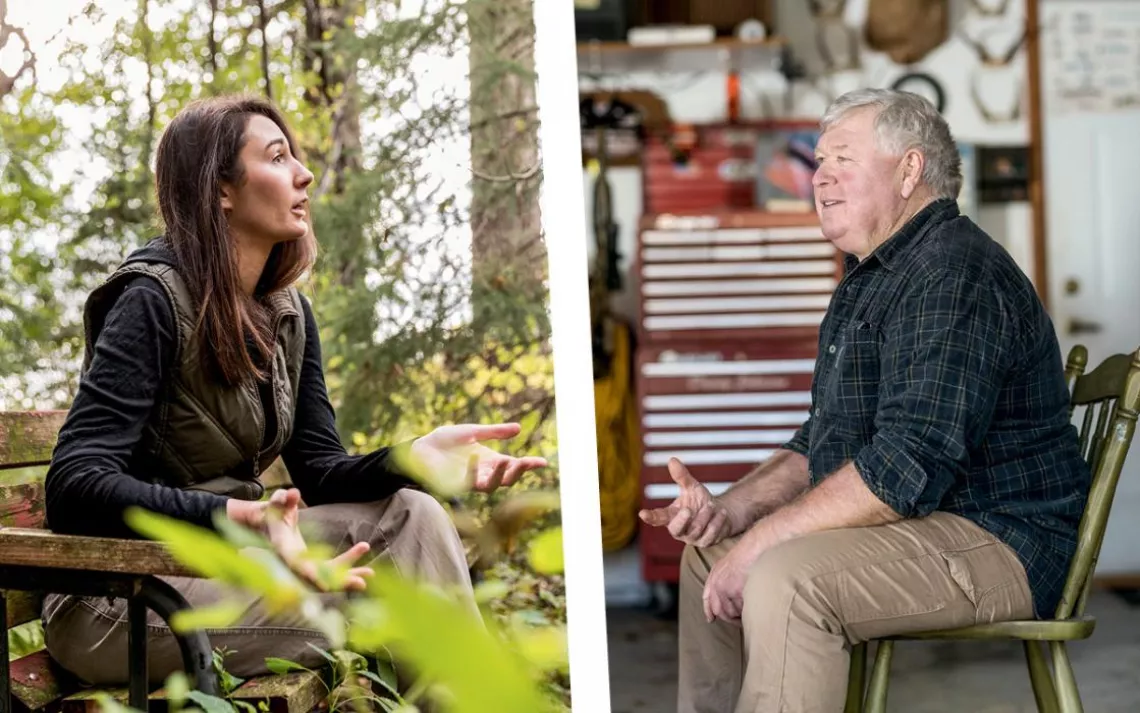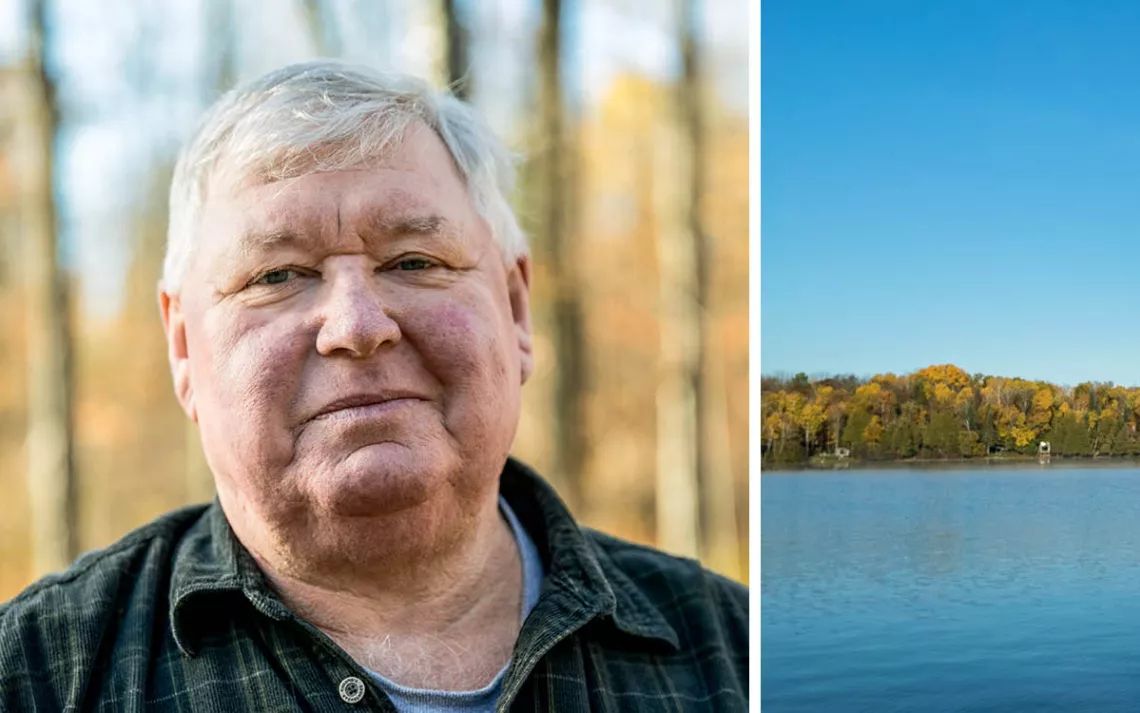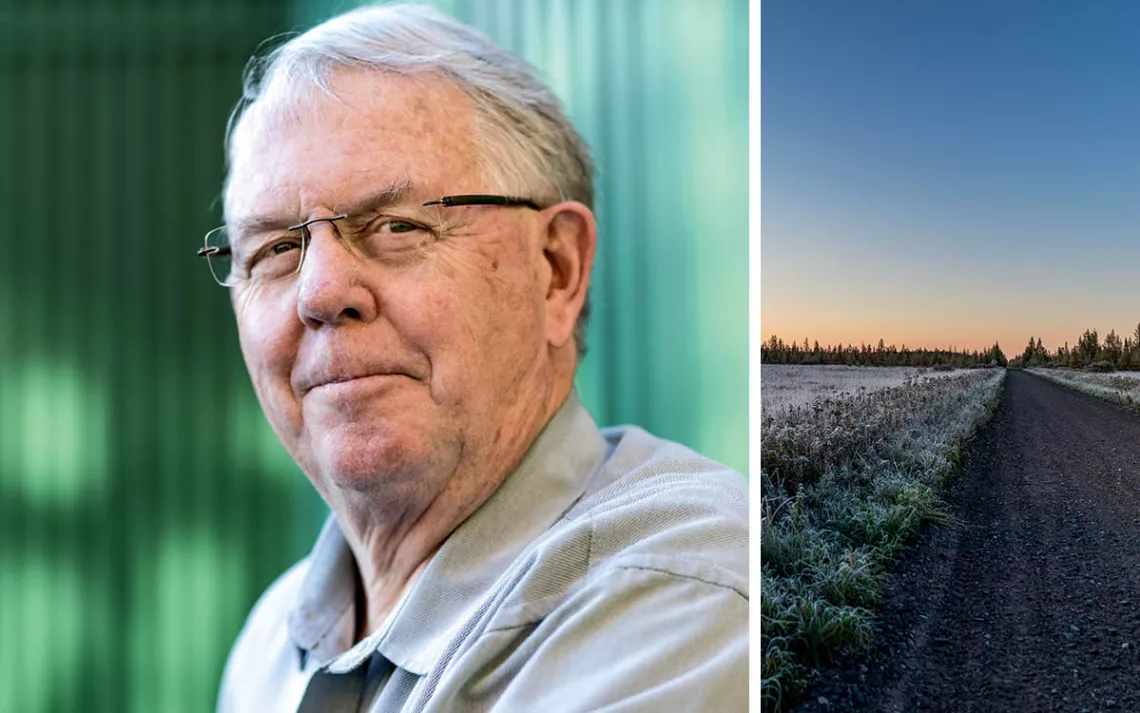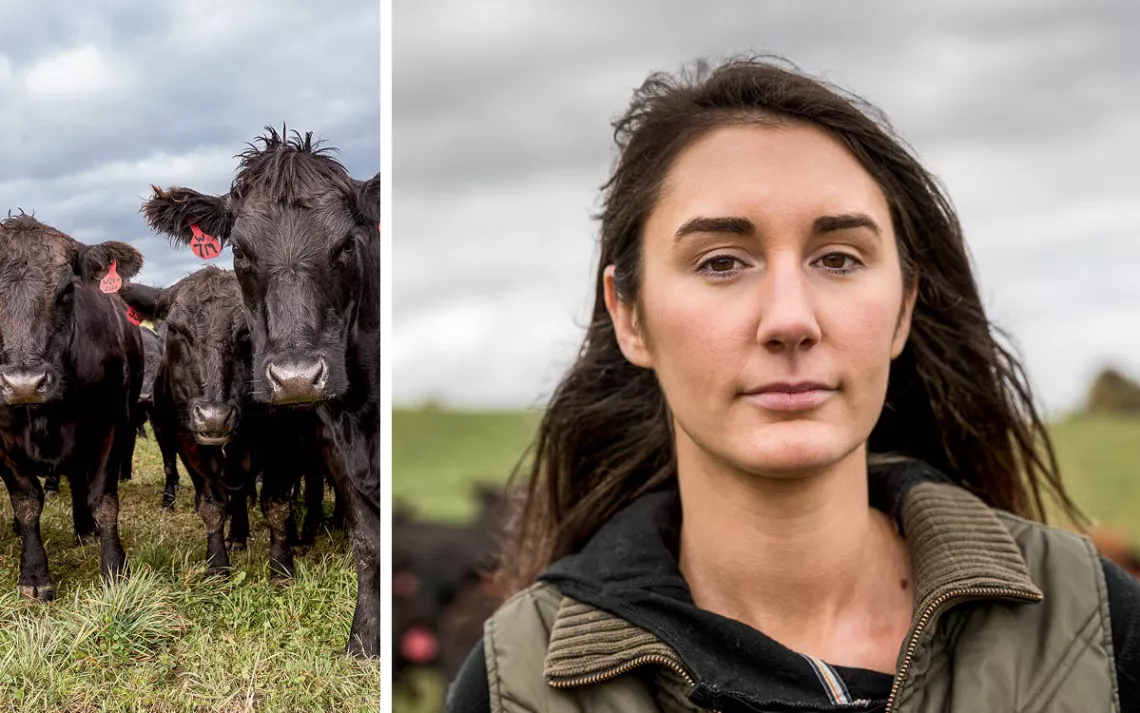Talking About Climate Change in Trump Country
In Minnesota, "Rural Climate Dialogues" get people across the political spectrum to discuss global warming

Photos by Sara Rubinstein
FOR 47 YEARS, HARVEY KRAGE LIVED IN a white farmhouse with red shutters on the side of a bluff about 11 miles from the Mississippi River in southeastern Minnesota. He and his family kept ducks in a pair of ponds and drank water from the springhouse in their backyard. For three decades, Krage commuted from the farm through a woodland of red cedar and black maple, past corn and bean fields, to the small city of Winona, where he retreaded massive, heavy construction tires for Goodyear Tire & Rubber Company. Then for another decade, he drove the company's semitrailers, passing the long hours with talk radio, especially the diatribes of right-wing commentator Rush Limbaugh. That's how he first heard about climate change, "about how crazy these scientists were."
As the years went on, the rains came heavier and more often. But his opinion about climate change didn't budge—not even when floods tore through his region in 2007 and about 18 inches of rain drenched his place in just three days. Two and a half feet of water slopped into his basement and lifted his freezer off the floor. In the nearby town of Rushford, every downtown building was trashed with mud. A city councilor there told the Associated Press it was "our Katrina." The Minnesota governor declared a state of emergency.
Over the years, the summer heat became increasingly unbearable, but the rising temperatures didn't spur Krage to change his views about global warming. In 2011, parts of Minnesota broke records for high dew points. The temperature in Winona swelled to 93°F, but it was so muggy that the official heat index put the temperature at 114°. Nor did he think much about climate change in 2013, when another big rain caused mudslides throughout the county. Krage found himself arguing about it with his more liberal adult daughter. "Global warming," he said, "to me, it was a farce."

David Johnson, a retired construction worker and Trump supporter
Then in early 2016, two years after Krage retired, a postcard appeared in his mailbox: an advertisement for a three-day event called the Rural Climate Dialogues. The gathering was sponsored by the Institute for Agriculture and Trade Policy (IATP), a think tank focused on farm policy, and the Jefferson Center, an organization that specializes in facilitating political discussions. The event was by invitation only, and one had to apply to participate. If chosen, Krage would join "a randomly selected, demographically diverse microcosm of Winona County." He remembered thinking, "Hey, why not?" And so Krage was one of a few hundred who turned in an application with basic information, including age (72 at the time), party affiliation (Republican), race (white), and education level (high school diploma).
After he was chosen, Krage entered the dialogue heavily armed with doubt. A blue-eyed, crackly-voiced guy with a vague resemblance to Dave Thomas, the founder of Wendy's, Krage seems amiable enough. But, he said, "I went in thinking that I was going to be the rebel of the group."
In total, there were nine men and nine women; five Republicans, five Democrats, and eight independents; 12 people with bachelor's or advanced degrees and six with none. There were only two people of color, but since the county is 94 percent white, that seemed reasonable enough to the organizers (although one of those two participants insisted later that the dialogues weren't reaching "the right community"). The group included conventional farmers and an organic-farm worker, an occupational therapist, and a retired executive assistant turned "full-time grandma."
It was a collection of people plucked from opposing sides of the political spectrum and the socioeconomic divide, packed into a room to discuss a hot-button subject—a recipe for a shouting match, given the political climate of the last few years.
Krage listened as a climatologist, Mark Seeley from the University of Minnesota, explained that the 2007 floods were among seven powerful mega-rainstorms to strike Minnesota in just 14 years. Before that, there had been only seven such storms in nearly 150 years. When the discussion turned to the region's water issues, Krage leaped to his feet and began asking questions. "I was so fascinated, they actually told me to sit down and not talk so much," he recalled.
By the end of day three, a couple of extraordinary things had happened. First, the participants managed to get along well enough to draft a collective statement with recommendations for county officials. "Evidence suggests that Minnesota's climate and weather are changing more rapidly and more dramatically than in many other parts of the country," the statement read. "These changes will have a real measurable impact on our overall economy, our environment, fish and wildlife habitat, health, insurance rates, and more." Second, Harvey Krage changed his mind.
"I came out of it a total winner as far as believing in global warming," he said.
I FIRST HEARD ABOUT THE Rural Climate Dialogues in early 2017—when the nation's politics seemed to have sunk deeper than ever into a morass of divisiveness and the prospects for bipartisan agreement on environmental issues felt especially dismal. The reliability of basic facts—the very nature of truthfulness—seemed to be on trial across the country. It felt increasingly difficult to reach across the political divide and influence anyone on the other side. The human brain, it turns out, is a feistier and more unreasonable organ than most of us realize: It reacts defensively against information that threatens a person's sense of identity. According to a series of scientific reports, it is extremely difficult to use facts to alter someone's opinion, especially a strongly held one.
Today in the United States, identity politics seem to express themselves along geographic lines as much as racial and socioeconomic ones. In 2014, the Pew Research Center found that conservatives and liberals had sorted themselves into different parts of the landscape, with conservatives far more likely to prefer small towns and rural areas. That same year, the National Climate Assessment devoted a chapter to rural communities. The authors found that rural economies were "inherently vulnerable to climate change" and especially at risk because of geographic isolation, poverty, and aging populations.
But strident voices on the American right—pundits like Limbaugh, politicians like Senator James Inhofe of Oklahoma and many Republican members of Congress—have told the public that climate change is a left-wing issue. So in rural America—that is, in politically conservative and predominantly white America—it's been hard to start a conversation about global warming. In a 2013 poll, for instance, only 16 percent of Iowa farmers agreed that "climate change is occurring and due primarily to human activities."
Anna Claussen, a farmer's daughter and a director at the IATP, based in the Twin Cities, was concerned about how hard it was to talk to people in agricultural communities about an issue that so affects their lives. So four years ago, the institute contacted the Jefferson Center, also based in Minneapolis, for help.

Professor Mark Seeley, University of Minnesota Extension climatologist and meteorologist
The Jefferson Center developed its approach to civic engagement during the 1970s. The organization's founder, a political scientist named Ned Crosby, lamented that public opinion polls produced shallow responses: "The citizen has no time to reflect upon the answer," he wrote in a 1974 report. But if you organized people into, say, an advisory committee, you could end up with a one-sided, self-selecting, and possibly self-interested group. To get around both problems, Crosby created a method he called the "citizens jury." The first step was to randomly select participants from representative demographic segments. The next was to supply them with information, in the form of testimony, as if they were a jury in court, and then engage them in deliberation. They would talk through the matter at hand and come to some sort of collective conclusion. Over the next few decades, the Jefferson Center used citizen juries to tackle issues such as water pollution, physician-assisted suicide, welfare reform, and traffic congestion.
The goal of the juries is to sample the voice of the public and offer informed citizen input on a given topic. But the method also has potential for persuading people to shift their minds on the issue before them. While there is scant evidence about what influences someone to make an enduring shift in opinion, research suggests that "self-persuasion" plays a role. In other words, you can't just absorb information that is catapulted upon you by experts or strangers. You have to navigate the obstacle course of your own doubts and assimilate new information into your life experience. And if you do this within a group, as the citizen jurists do, those shared experiences can also hold lasting sway.
When the Jefferson Center helped the IATP organize the first climate dialogue—in June 2014, in Morris, a prairie town of 5,000 people—Claussen was nervous. "It was really scary going into it as a pilot," she said. Three other events followed in Minnesota—in the summer of 2015 in Grand Rapids, the one Krage attended in early 2016 in Winona, then a wrap-up event in the fall of 2016 in the Twin Cities that reconvened some of the original participants. In each, there were moments when the participants needed redirection—someone might steal the floor and soapbox about flooding or the trees that died in their backyard. "In Morris on our very first day, the tensions rose quickly with somebody who you could tell came with a lot of animosity and concern," Claussen remembered. More than one person thought about dropping out. But no one stormed away.
The first day of the Rural Climate Dialogues relied heavily on the folksy charm of Seeley, the University of Minnesota’s climatologist, who also hosts a public radio program focused on the state's weather. A jovial 70-year-old with blue eyes framed by well-worn laugh lines, Seeley has spent four decades traveling to nearly every small town in the state, and he's learned to serve up climate data in plain language, in a baritone as soothing as apple butter. Seeley has found that, even if it's touchy to broach politics or climate change, he can always talk about the weather.
He admitted, a little sheepishly, that he was a "doubter" of climate change in the 1980s, at a time when scientists had started discussing the subject but the public still knew little. Minnesota weather is so variable that it can be hard to spot a trend line through the noise of heat waves and cold snaps. Then Seeley had his own moment of self-persuasion: He wrote weather reports every week, and in the 1990s "more and more frequently I was looking at numbers, measurements, that I had not seen before." One after another, state temperature records were being broken. "And I'd say, 'What am I doing here? I've never written that number before. Am I writing about Minnesota, or am I writing about Mars?'" In 2011, Seeley studied the new weather averages for Minnesota from the World Meteorological Organization, calculated between 1981 and 2010. The state was at least 15 percent wetter than it had been at the beginning of the 20th century—one of the largest shifts in weather seen across the country.
He told the groups gathered at the climate dialogues that nothing in Minnesota's history paralleled some of the weather extremes they were witnessing. After Seeley's presentation, the groups had a chance to talk through their experiences of strange weather—the shortening of winter, the ferocity of rainstorms, the oppressive summer heat. By the end of the first day of the Morris dialogue, Claussen said, "that climate-denial frame, I think, was really set aside." She felt the tensions in the room quiet. "You also saw people set aside their assumptions about each other."
IN AUGUST, I DROVE THROUGH rural Minnesota to seek out some of the former climate jurors. I wanted to know if the dialogues were really as successful as the organizers claimed. Could you hold a meaningful conversation among people of different political orientations, whose versions of reality were so irreconcilable? And even if you could, would this reflect anything about public opinion? A cynical part of me thought the climate dialogues might be a little kumbaya for today's abrasive political culture.

Shona Snater, a one-time organic-farm worker
I headed to Grand Rapids—an 11,000-person town on the upper Mississippi, in Itasca County, where I met David Johnson, a retired construction worker. The front of his house was festooned with six American flags. The antlers of several deer he'd bagged hung above the back door. One of the biggest walleyes he'd ever hooked was mounted in the back entryway. His wife, Rita, had hung a number of pictures with ecofriendly slogans around the house. One had a biblical quote: "Hurt not the earth, neither the sea, nor the trees," from the Book of Revelation.
Rita had talked about climate change for years, but David hadn't paid a lot of attention. Then he attended the Grand Rapids climate dialogue a year and a half before the election, and he became passionate about the issue. In general, though, Johnson's neighbors remained quiet on the subject. Sure, people noticed that the ice-fishing season had shrunk by several weeks. For loggers in the region, it had become tricky to harvest swampland timber—something usually undertaken in the dead of winter, when heavy equipment can be pulled onto the frozen peat. But in polite company, one never knew whether the phrase "climate change" might offend.
In the fall of 2016, Johnson noticed the proliferation of Make America Great Again yard signs along the wooded drives that loop around Grand Rapids. "It was kind of strange because this has always been Democrat up here. I mean exclusive," he said. "Buy Chevrolet. Join the union. Buy the stuff from the USA. I mean, it used to be strict."
The last time Minnesota gave its Electoral College votes to a Republican was in 1972. In the 2016 election, the state as a whole chose Hillary Clinton. But Minnesota isn't immune to the divisions affecting the rest of the country. Outside the Twin Cities and Rochester metro areas, most rural voters in Minnesota preferred Trump. In Itasca County, 54 percent of voters cast their ballots for him. And climate change was not an issue that swung most voters there, not even Johnson, who voted for Trump because he liked the candidate's "blue-collar" message about "upgrading our military and creating more jobs."
But the issue of climate change had remained on Johnson's mind, and he often raised it with people he knew. In the first several months of Trump's term, "one of my biggest disappointments of him was to leave that clean-air agreement, the Paris Agreement—why?" he said, a sharp note of irritation in his voice. "Things were going such a positive direction, and he pulled out and stirred up the whole thing."
I spoke with other climate dialogue participants who recalled the events with enthusiasm, though only a few had become involved with climate change advocacy. Not all had undergone a dramatic conversion, but for most, the issue had taken on greater importance. At a picnic table at Itasca Community College, I met with a therapist named Melissa Weidendorf, who told me she'd left the Grand Rapids dialogue with a certain amount of despair and a determination to stay engaged: "I think about the opportunity to have grandkids and kind of teach them about northern Minnesota and what it's like to live up here and kind of appreciating what we have," she said. "And I'm like, how long will we have it? Is that even a viable opportunity anymore?"
Still, there were critics, like Jim Barker, a retired miner, onetime ExxonMobil engineer, and Libertarian who spoke with me at his house at the edge of a sunlit lake. He thought the threat of climate change was overblown. "People here are very adaptable," he insisted. "You roll with the punches." If there wasn't enough snow for snowmobiling, you could ride an off-road vehicle; if there weren't enough walleyes, you could fish for largemouth bass.
I began sidling up to strangers in Grand Rapids and asking their views to see how they compared. The easiest place for such conversations was the Itasca County Fair. A man selling recreation vehicles there told me he thought global warming was a hoax. A pair of people who worked for the local cable company said most people noticed climate change but didn't talk about it.
In a barn full of educational displays and community booths, I stopped by the Republican Party's table, where a woman in a flower-print dress and a pearly necklace introduced herself as a former county commissioner. Most conservatives in the state, she said, would differ with Trump on environmental policy. "Definitely a lot of people in Minnesota would agree that there is climate change. We can feel it," she told me, without a note of hesitation in her voice. Kitty-corner from that booth, a local group called the Itasca Clean Energy Team was campaigning to install a small solar project in town. A man staffing the antiabortion-campaign booth adjacent to them told me he liked solar energy but he wasn't so sure about climate change. Then again, he said, maybe he didn't know enough about it.
AT EACH OF THE COMMUNITY DIALOGUES, the Jefferson Center and the IATP collected before and after surveys, then commissioned a University of Minnesota political science professor to analyze the findings. The results were promising, though not everyone was, like Krage, a "total winner" in the acceptance of climate change. At the climate dialogue in Grand Rapids, two people who had doubted whether global warming was occurring changed their minds; the number of people who were "very sure" or "extremely sure" that global warming was real climbed from 10 at the outset to 17 out of 18 at the end. In Winona, the number of very and extremely sure participants grew from about half to 15 out of 18 people (though two people left the event mistrusting the science of climate change). Among the 15 people gathered in Morris, there was a similarly substantial shift in opinion. By the end, all but one person said that extreme weather events would be more likely in the coming years.
Perhaps the most significant contribution of the dialogues was simply that they gave people permission to broach the topic at all, especially those who were already concerned but had difficulty knowing where to start. "There's a power in naming something," said Troy Goodnough, sustainability director at the University of Minnesota, Morris. Before the Morris dialogue, Goodnough was hesitant to say the words "climate change" outside his campus. Afterward, he, his colleagues, and a group of students began staging climate change education events, including a daylong discussion called the Extreme Weather Action Meeting. Goodnough assigned his students to sit down with local business and government leaders for conversations about climate change. Within two years, the local government had released a plan for climate resilience called the Morris Model. The university has set up several small solar projects. Morris is the Rural Climate Dialogues' greatest success story.
In Winona, the dialogue also opened the door to new conversations. Shona Snater, a 29-year-old who grew up there and majored in wildlife biology in college, didn't need convincing when she took a few days off from her job at an organic farm to attend the climate dialogue. Then about a year after the event, she took a position with the Land Stewardship Project, a soil-conservation organization, and regularly found herself talking with farmers, some of whom got edgy about anything that sounded too liberal. Her organization acknowledged climate change but rarely spoke about it with members. In April 2017, Snater began to test the waters by asking a few farmers if they saw a connection between soil conservation (which can store carbon) and climate change. "It's pretty hard," she admitted. "To tell you the truth, in the rural community—and this even goes for me—there is such a distrust of the government, a distrust of policies, that it's hard to believe anything that is said." But by summer 2017, Snater was asking farmers about the subject for a film she planned to put together.
At a time when national politics seem to be inextricably gridlocked, it's possible that change will have to happen like this, conversation by conversation, community by community. "Starting with the highest level of government and trying to convince these people right now maybe is the wrong direction to approach it," Seeley told me. "Maybe the right direction . . . is to approach it with the citizens where it's really happening."
In the 2016 election, Minnesota voters turned both houses of the state legislature over to Republicans, some of whom deny the science of climate change. But Seeley doesn't believe things will remain that way. "I think what's going on in the local communities is going to eventually translate to a recomposition of the Minnesota House and the Minnesota Senate to representatives of those communities that more fully understand and grasp what's going on with climate change," he said.
It's hard to be patient for this kind of political change when parts of the world are already experiencing extreme turmoil—as hurricanes blast apart communities in the Caribbean and the Gulf of Mexico, sections of Alaska collapse into the Bering Sea, and wildfires sear the West Coast.
Then again, we can't expect to understand one another if we're not willing to take the humbling step of having an open conversation. Maybe the problem is that we've just stopped trying to talk to each other.
This article appeared in the January/February 2018 edition with the headline "Can We Talk About the Weather?"
This article was funded by the Sierra Club's Beyond Coal campaign (beyondcoal.org)
This article has been updated since publication.
WATCH a video of the Rural Climate Dialogues in action: sc.org/climatetalk.
READ about the solar projects sprouting up in communities across Minnesota: sc.org/solargardens.
 The Magazine of The Sierra Club
The Magazine of The Sierra Club



